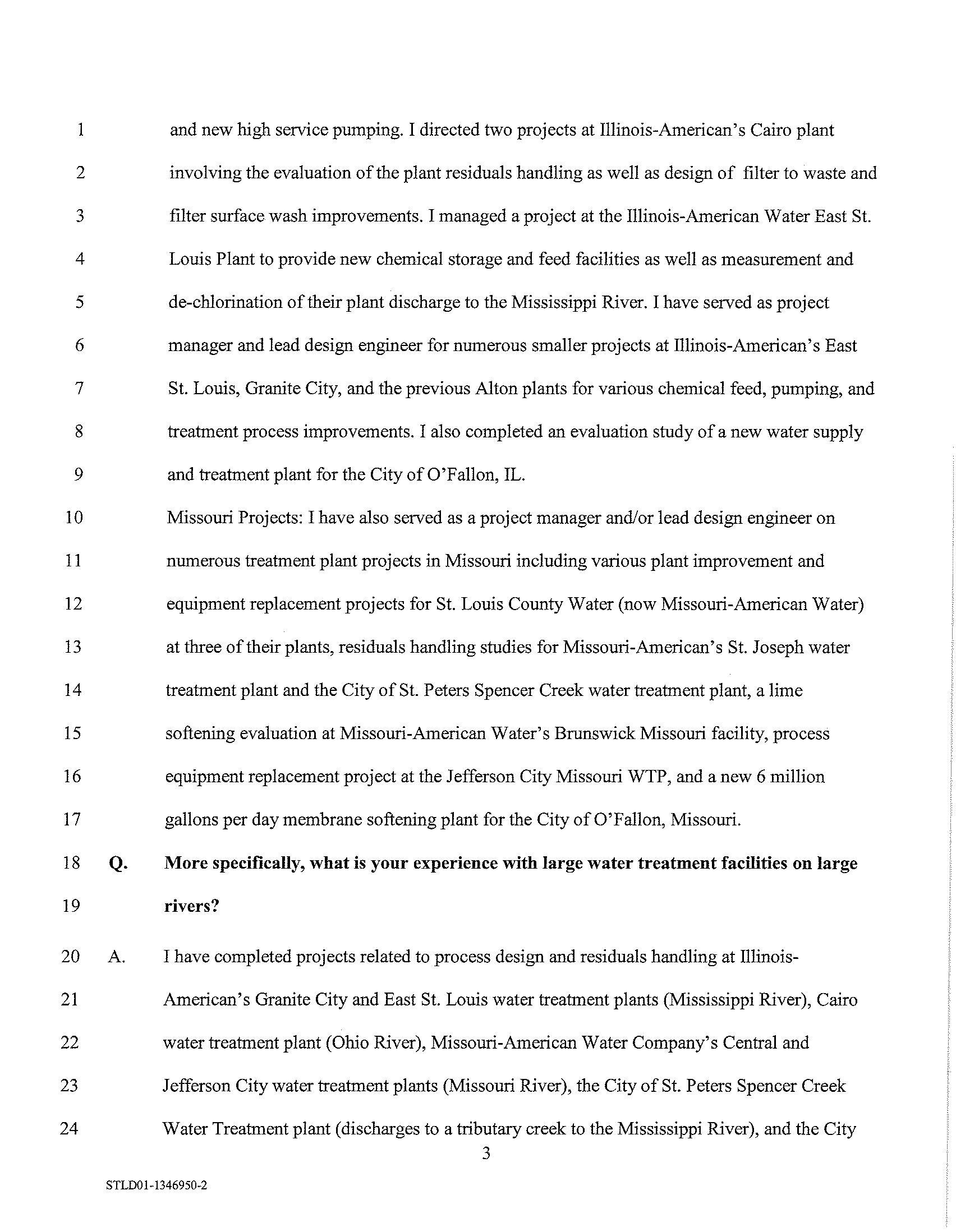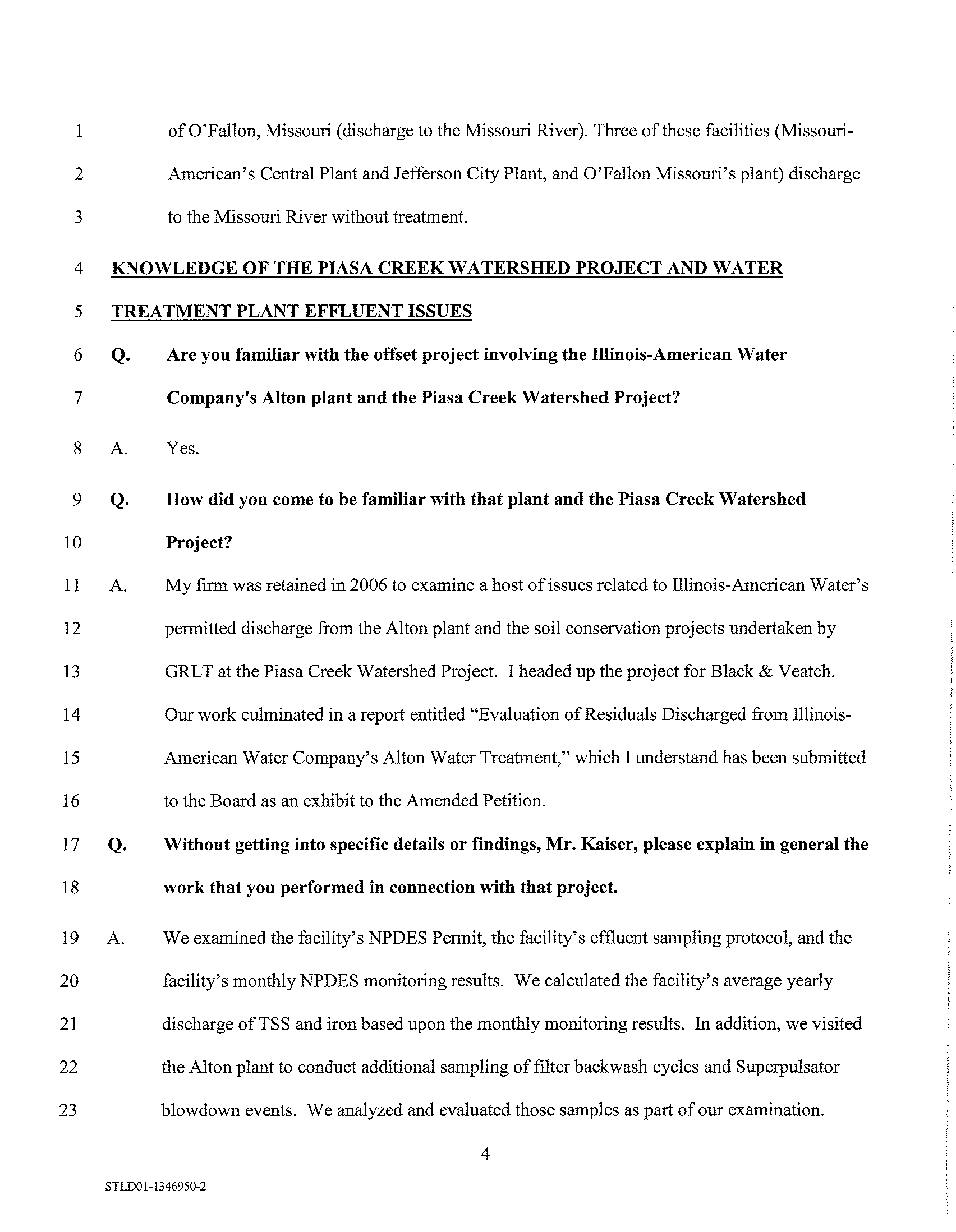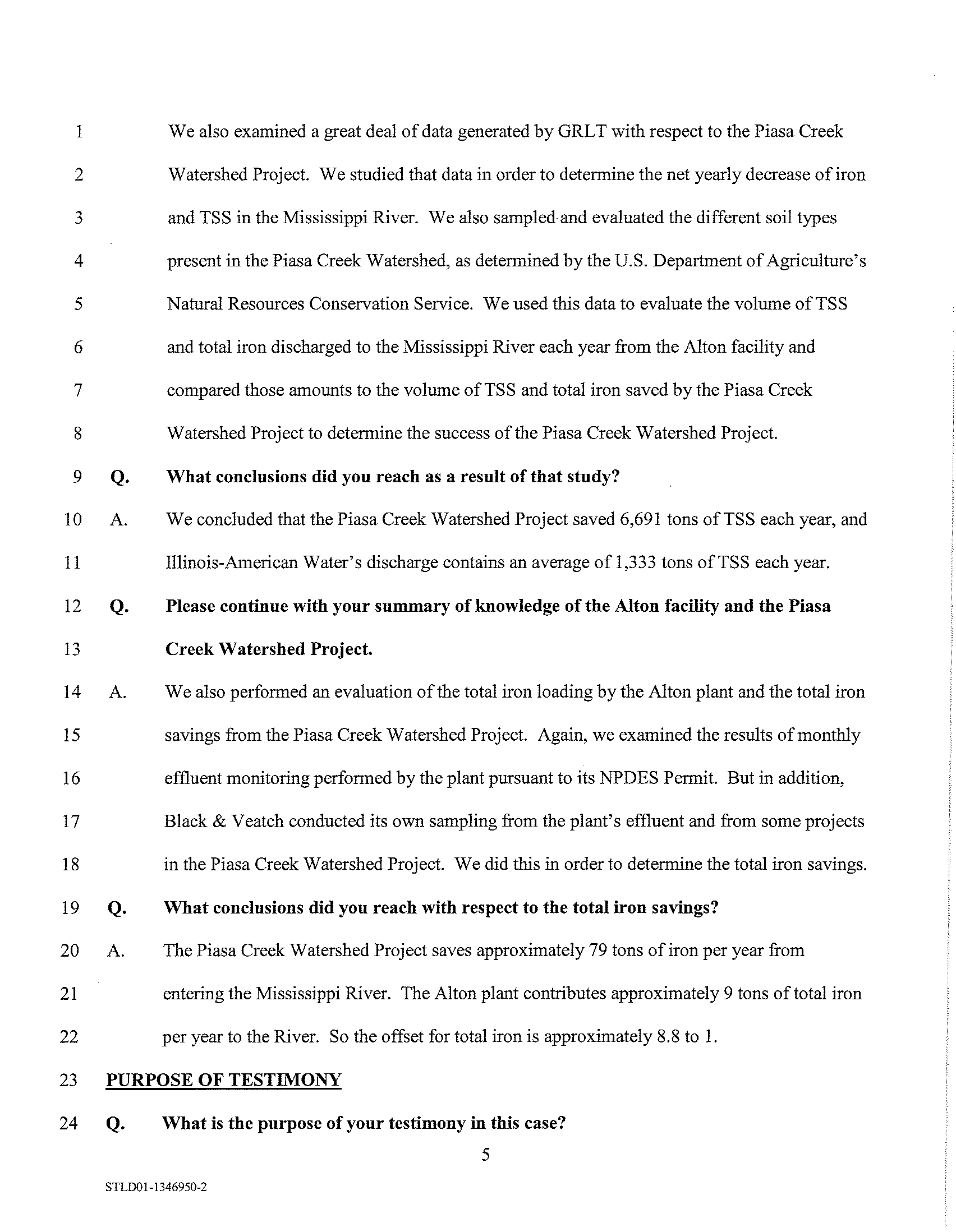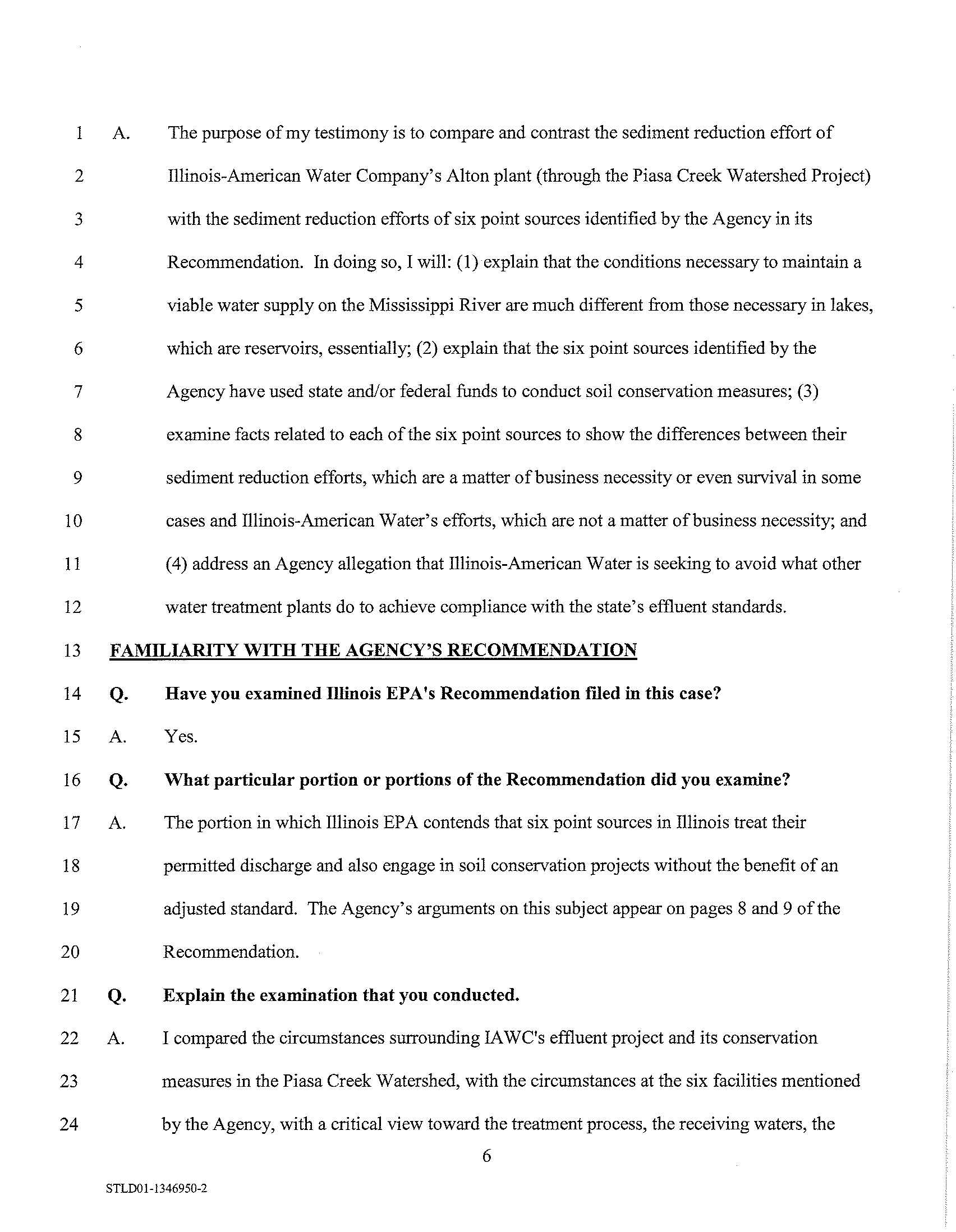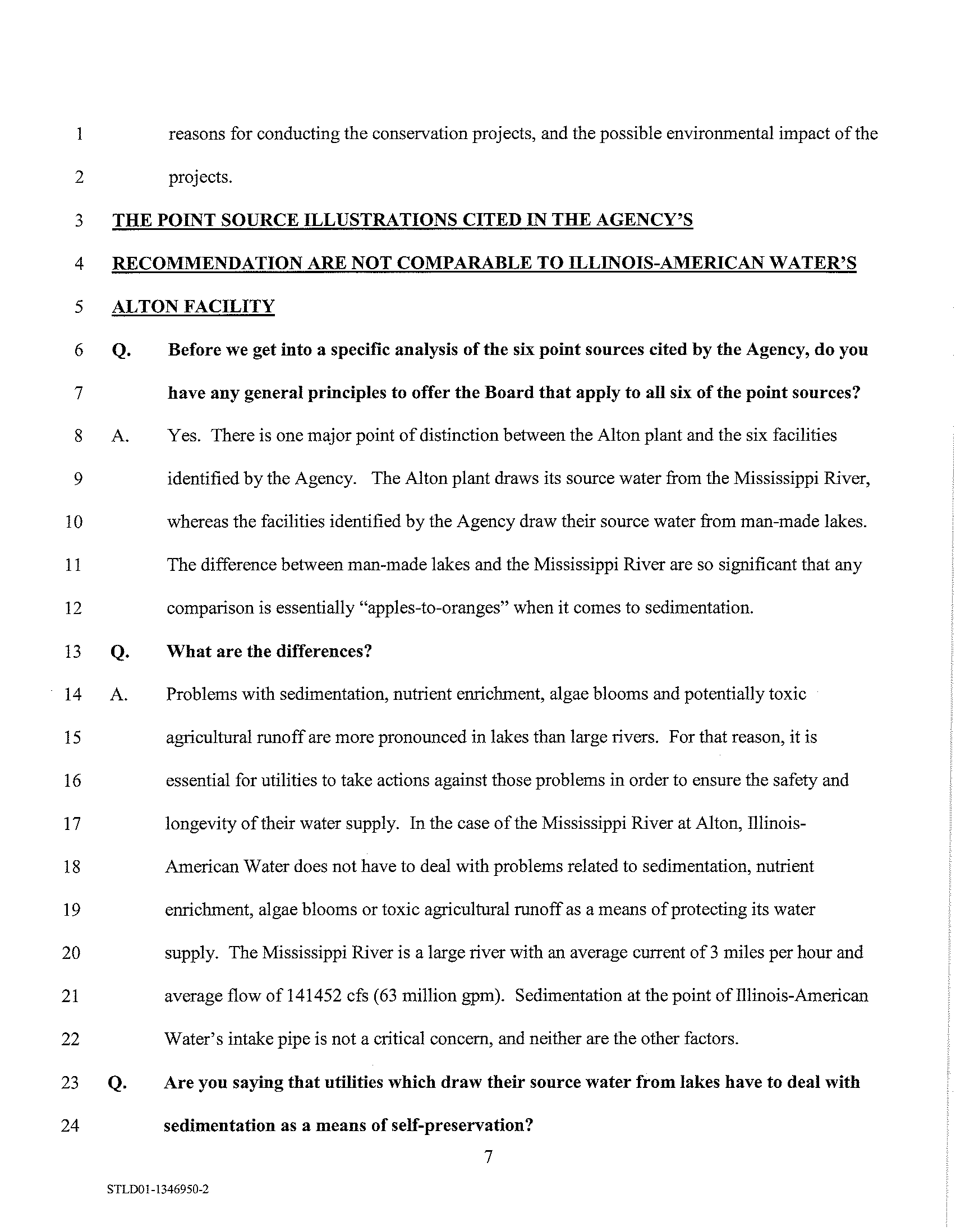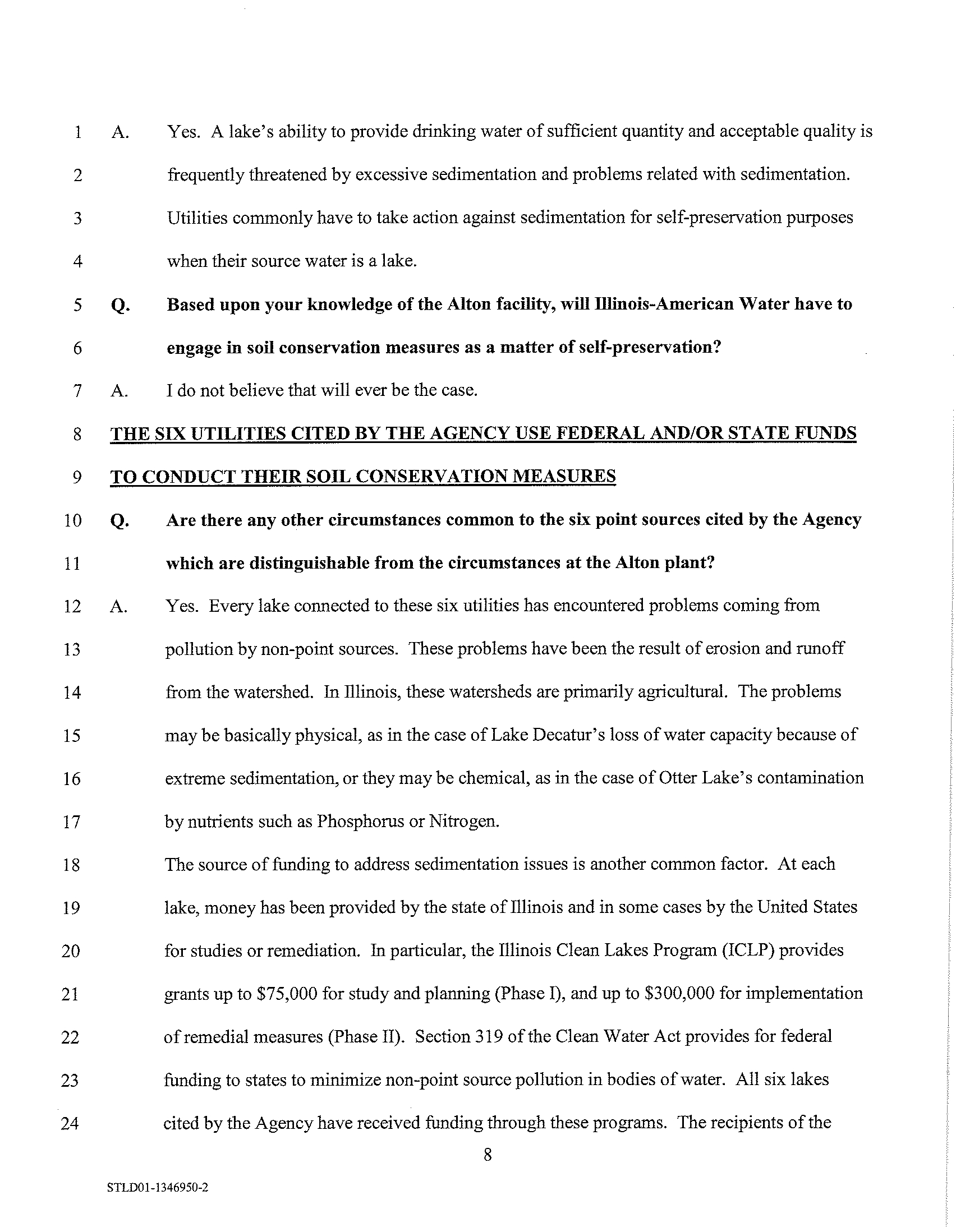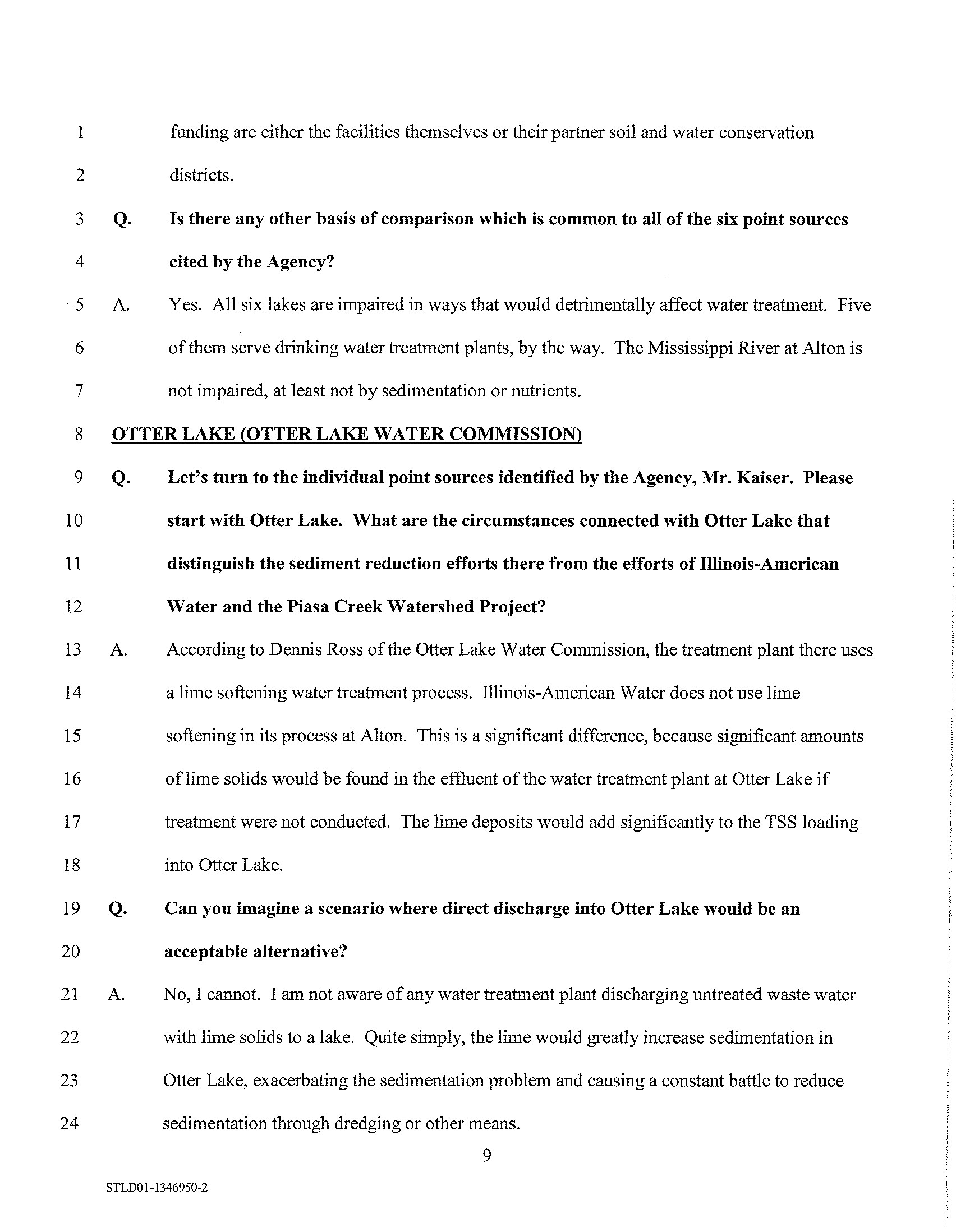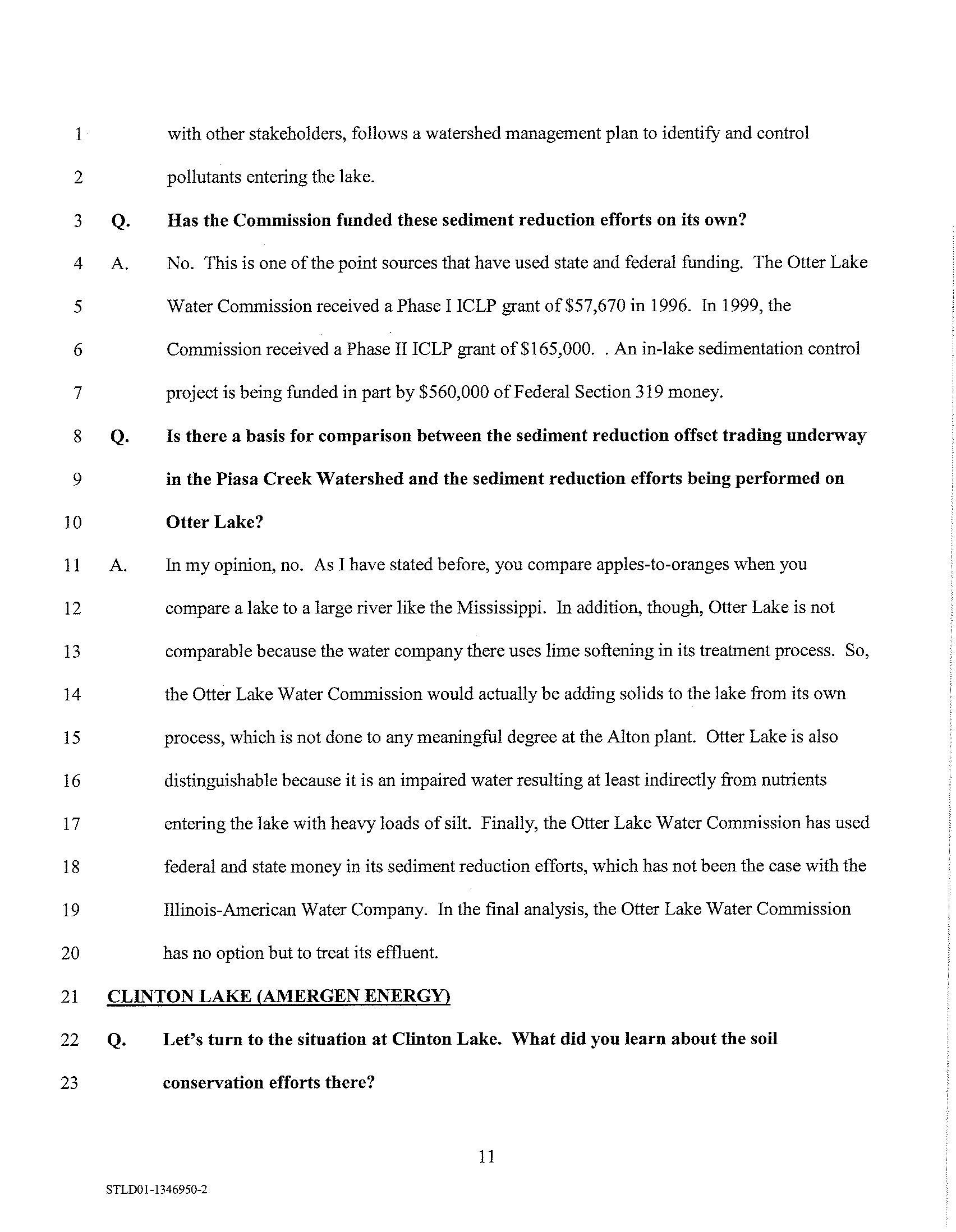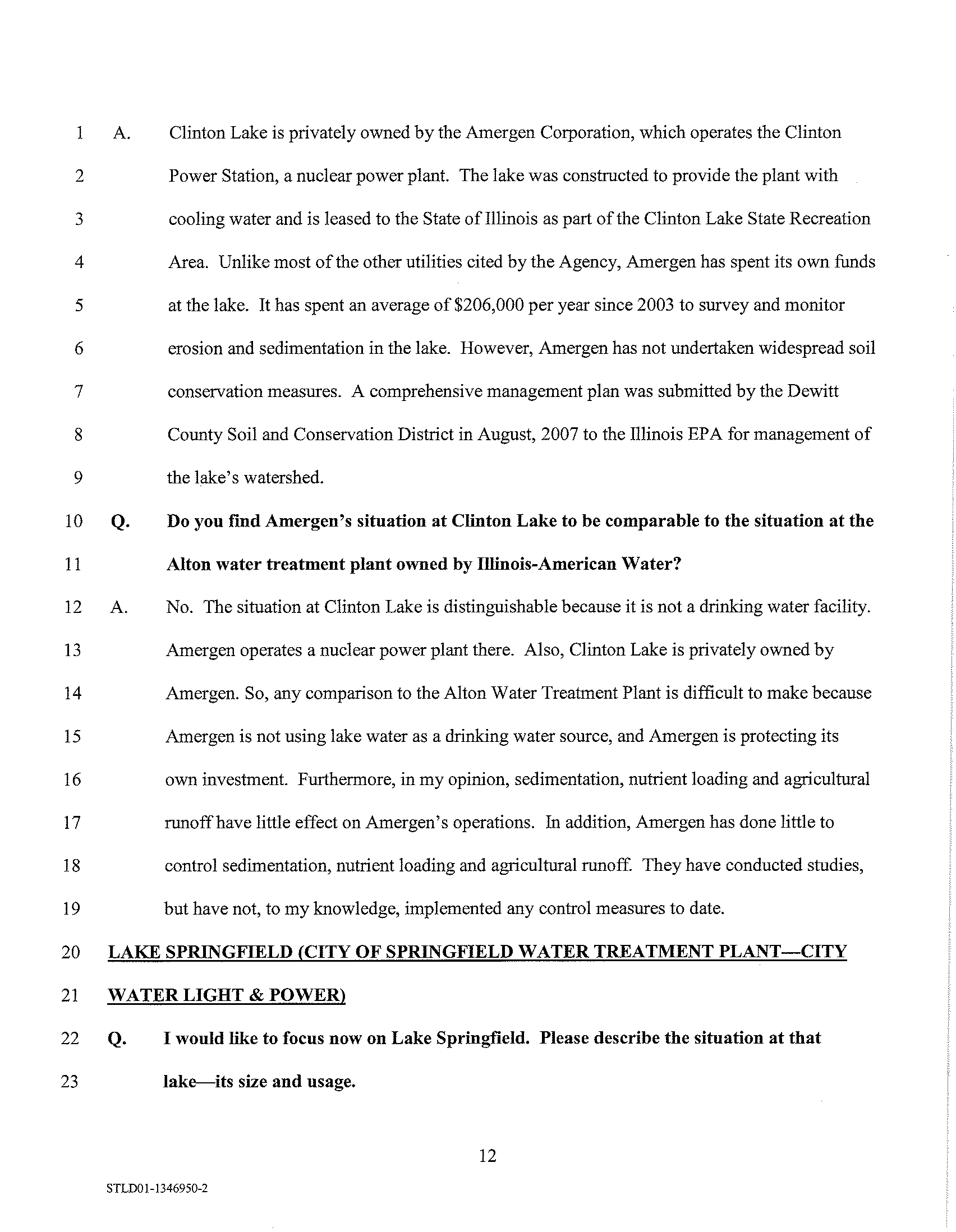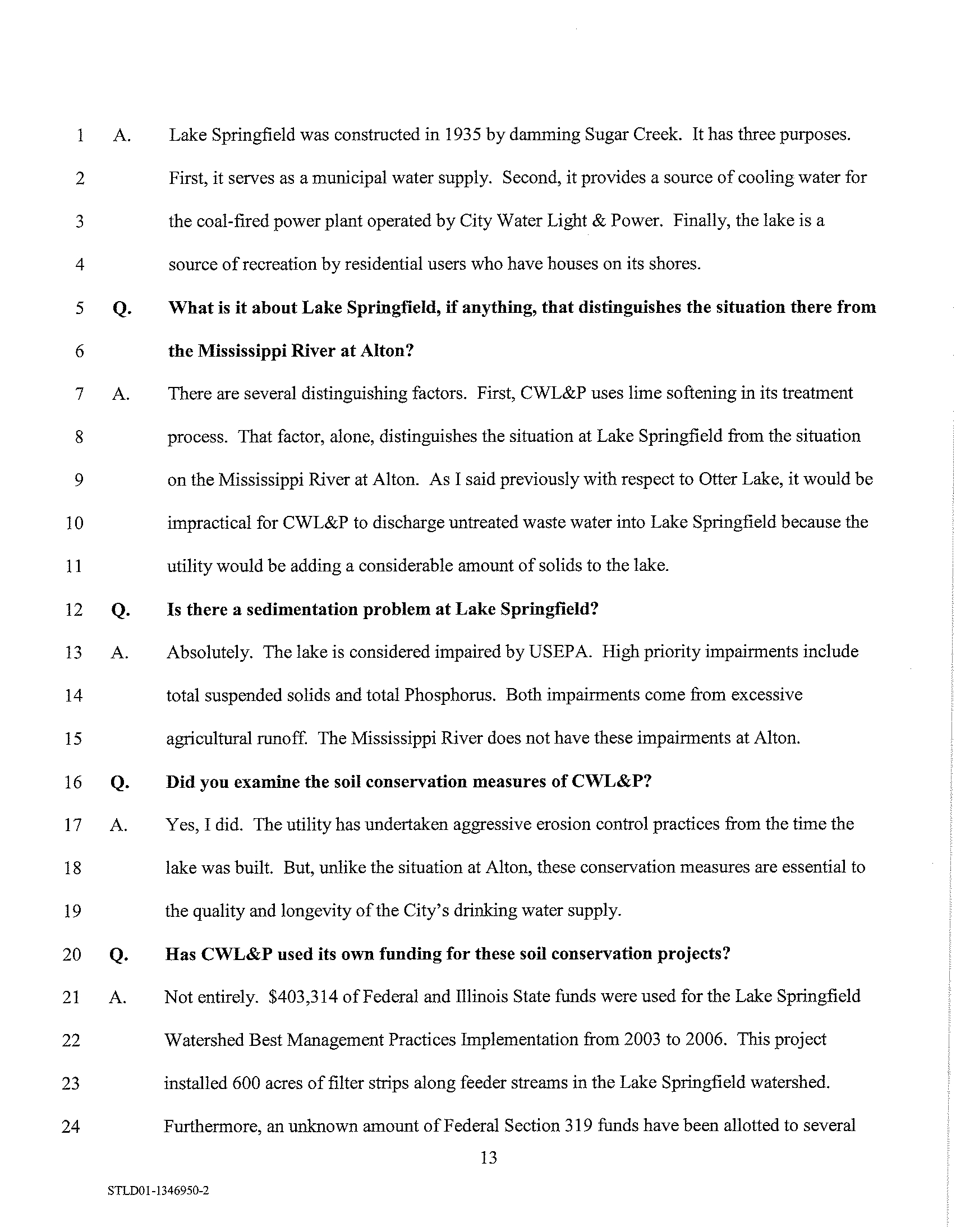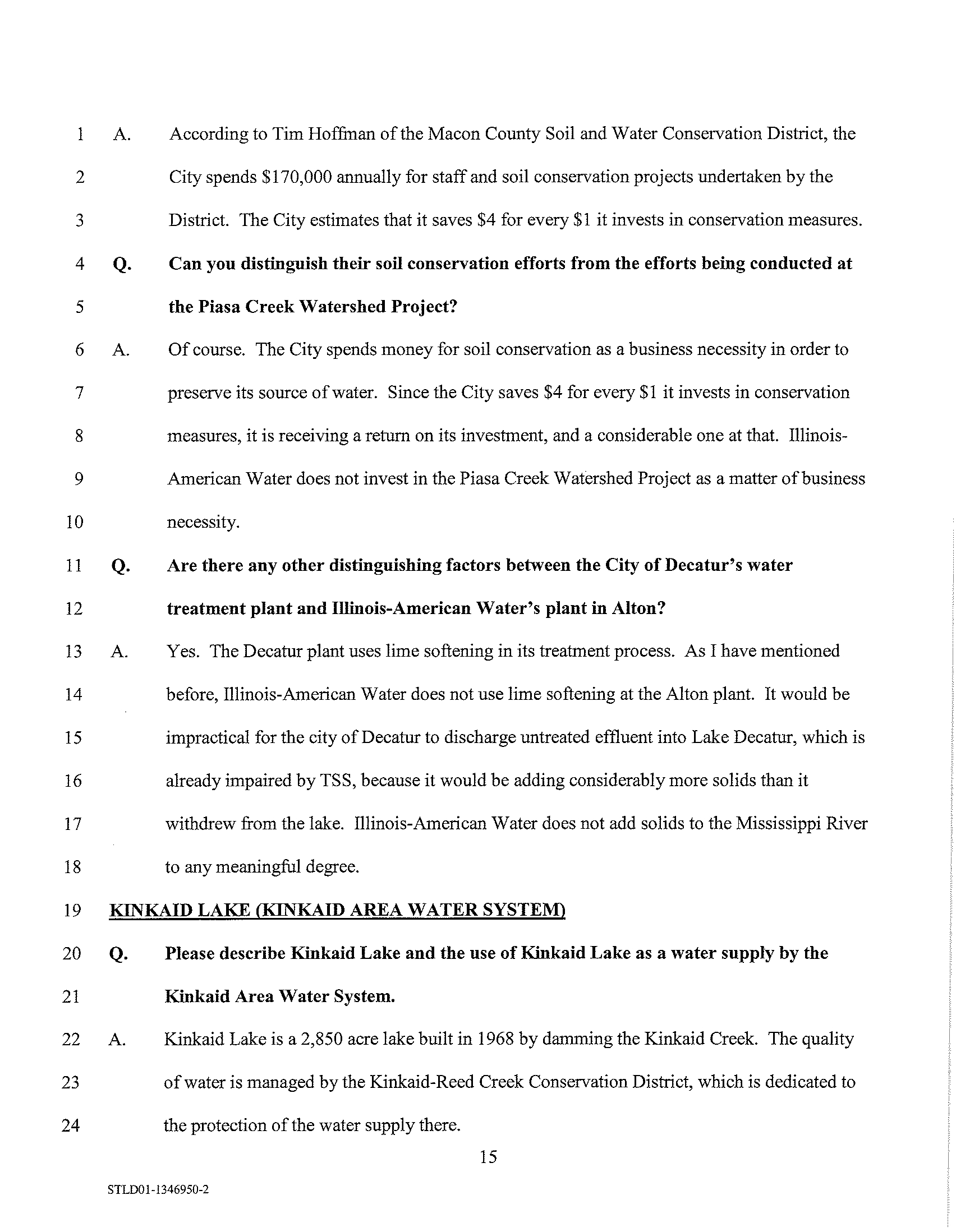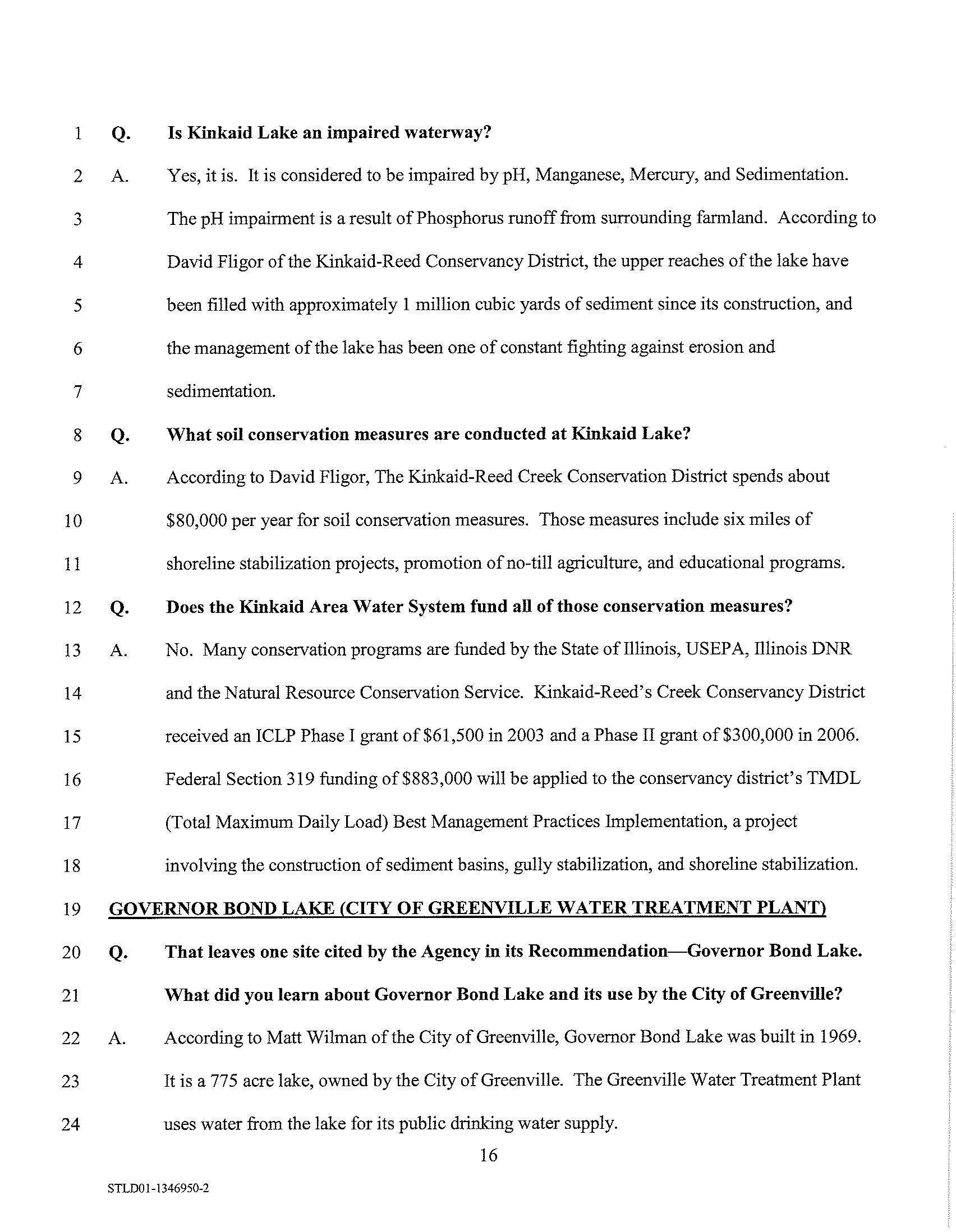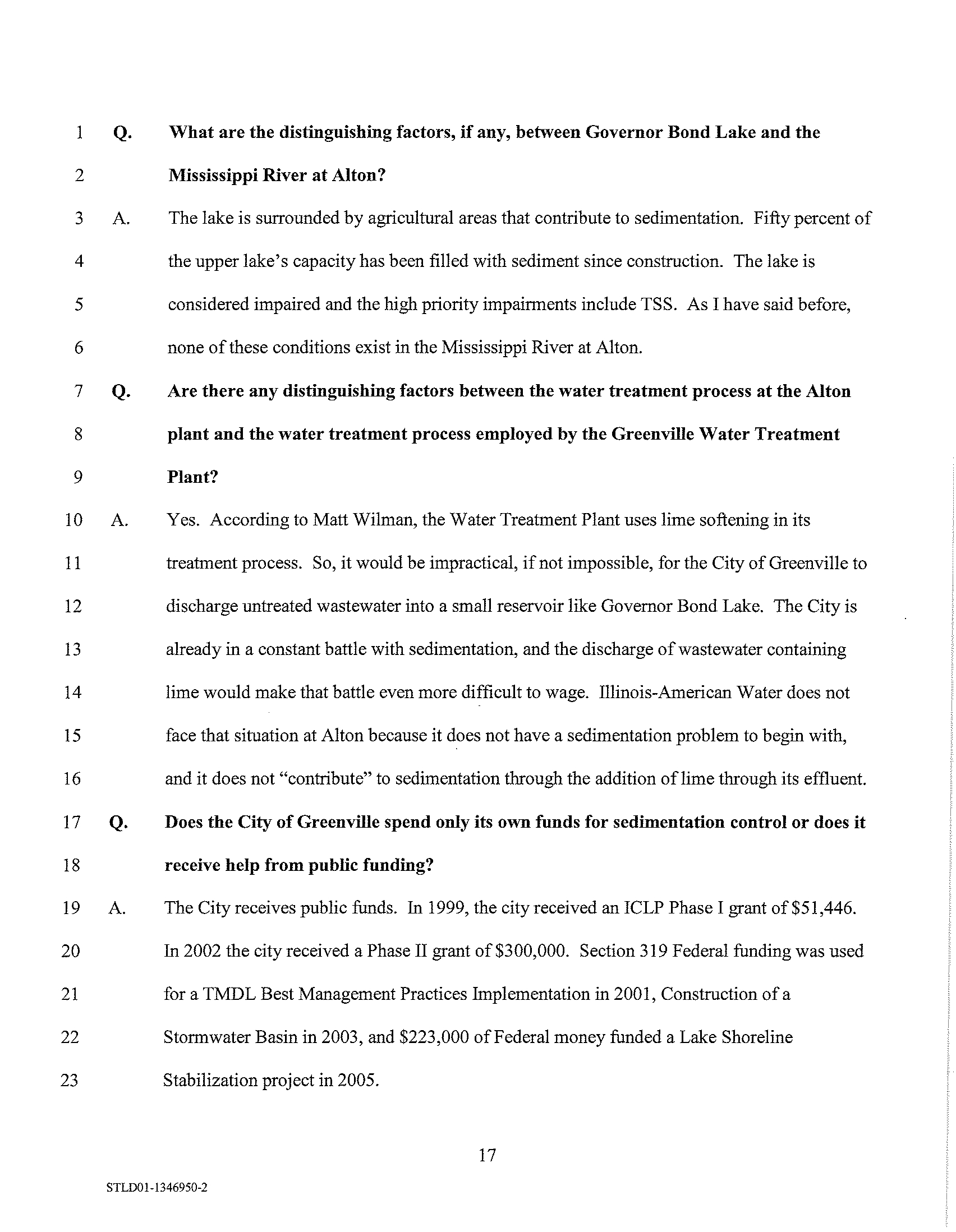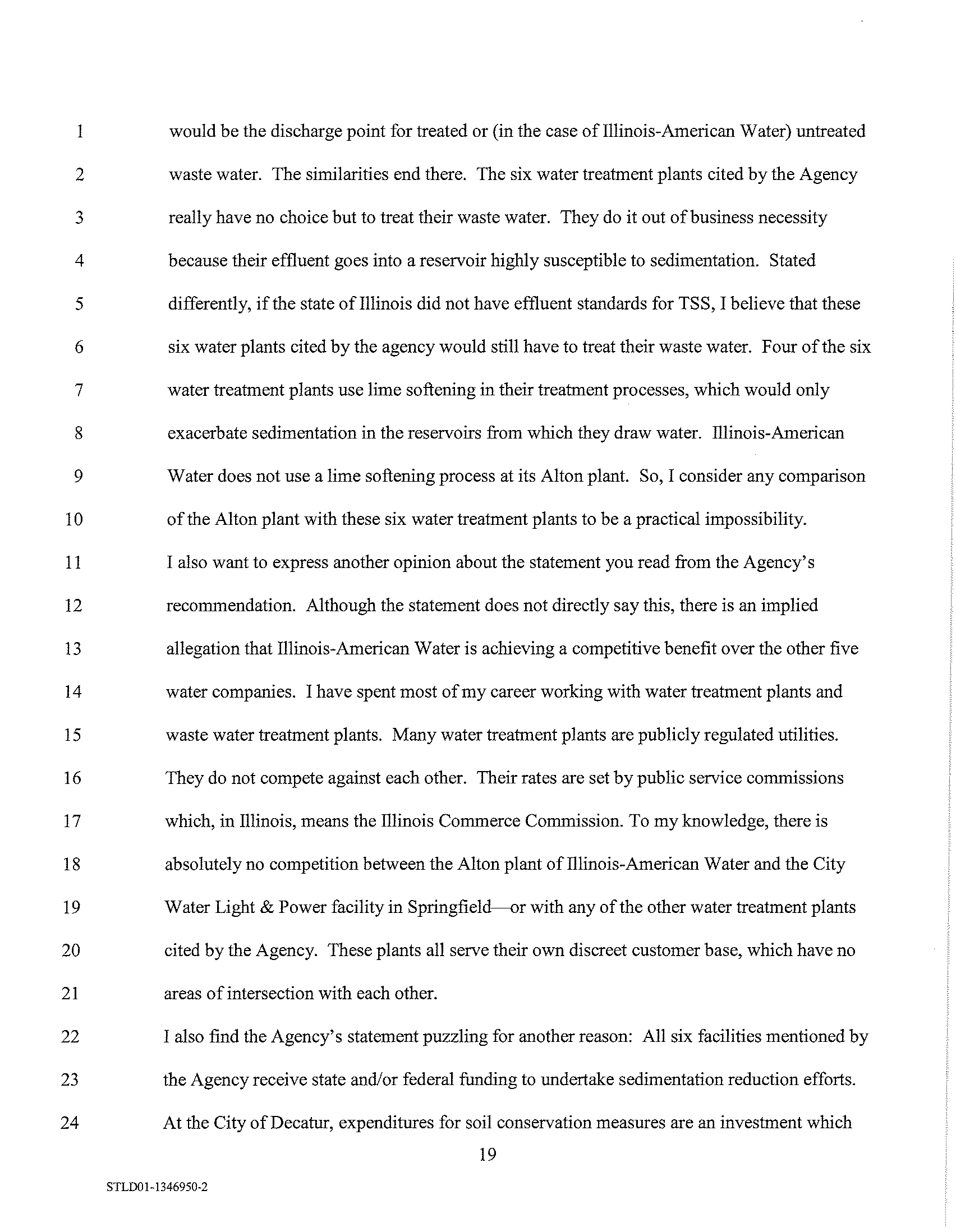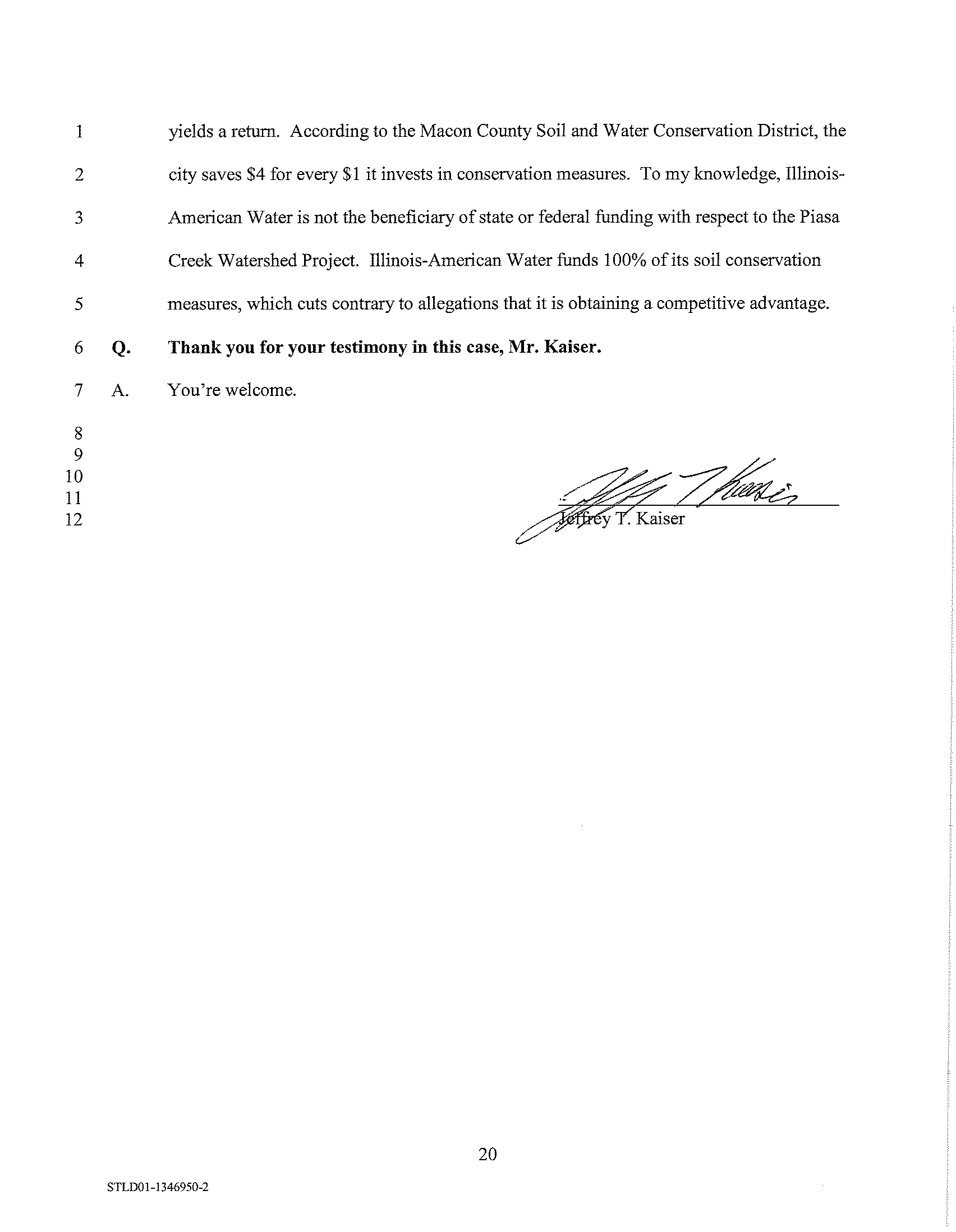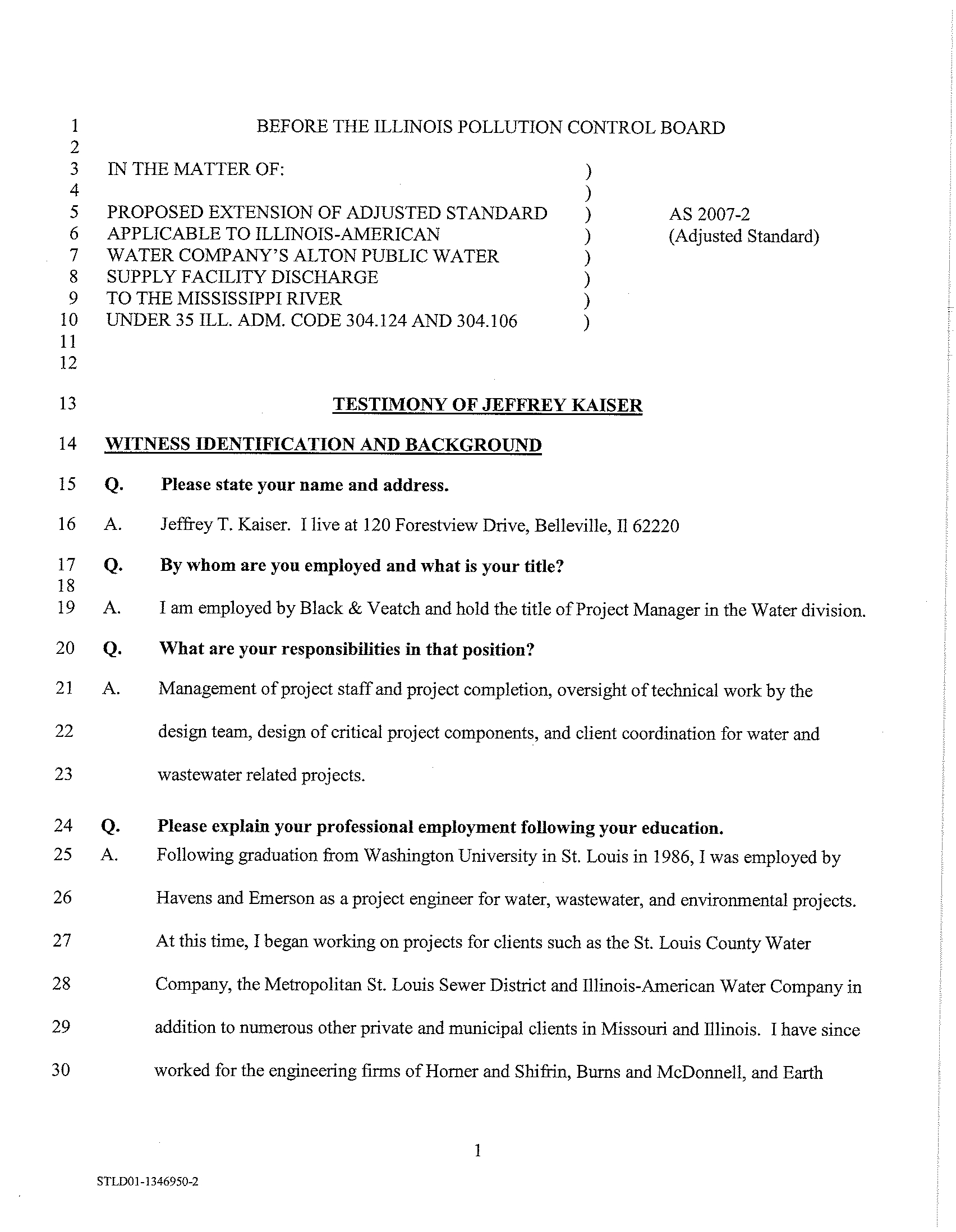
1
BEFORE THE ILLINOIS POLLUTION CONTROL BOARD
2
3
4
5
6
7
8
9
10
11
12
IN
THE MATTER OF:
PROPOSED EXTENSION OF ADJUSTED STANDARD
APPLICABLE TO ILLINOIS-AMERICAN
WATER COMPANY'S ALTON PUBLIC WATER
SUPPLY FACILITY DISCHARGE
TO
THE MISSISSIPPI RIVER
UNDER 35 ILL. ADM. CODE 304.124 AND 304.106
)
)
)
)
)
)
)
)
AS 2007-2
(Adjusted Standard)
13
14
TESTIMONY OF JEFFREY KAISER
WITNESS IDENTIFICATION AND BACKGROUND
15
Q.
16
A.
17
Q.
18
19
A.
20
Q.
21
A.
Please state your name and address.
Jeffrey T. Kaiser. I live at 120 Forestview Drive, Belleville, II 62220
By whom are you employed and what is your title?
I am employed
by Black
&
Veatch and hold the title ofProject Manager in the Water division.
What are your responsibilities in that position?
Management
ofproject staff and project completion, oversight oftechnical work by the
22
design team, design
of critical project components, and client coordination for water and
23
wastewater related projects.
24
Q.
25
A.
Please explain your professional employment following your education.
Following graduation from Washington University in St. Louis in 1986, I was employed
by
26
Havens and Emerson as a project engineer for water, wastewater, and environmental projects.
27
At this time, I began working on projects for clients such as the St. Louis County Water
28
Company, the Metropolitan St. Louis Sewer District and Illinois-American Water Company in
29
addition to numerous other private and municipal clients in Missouri and TIlinois. I have since
30
worked for the engineering firms
of Homer and Shifrin, Bums and McDonnell, and Earth
1
STLDOl-1346950-2
Electronic Filing, Received, Clerk's Office, August 24, 2007
I
2
3
4
5
6
7
8
9
10
11
Q.
12
A.
13
14
Q.
15
A.
16
17
18
19
20
21
22
23
24
Tech prior to
my current position at Black
&
Veatch. For each of those firms, my area of
focus was project management and/or design of water and wastewater facility projects.
I have completed planning and design projects for numerous water treatment facilities
including the City
of Chicago water treatment plants; Illinois-American Water facilities in
Peoria, Pekin, Alton (previous plant), East St. Louis, Granite City, and Cairo; Missouri-
American at the Central, South, and Meramec plants in St. Louis and in Jefferson City,
Brunswick, St. Joseph, and Joplin; and other water supply, treatment, and distribution projects
for the municipalities
of Washington, O'Fallon, and St. Peters, Missouri, and O'Fallon,
Illinois. I have also completed water supply projects for the Missouri Department
ofNatural
Resources, the USEP A, and the USACE.
Are
you professionally certified
in
any capacity?
I am a registered Professional Engineer in Illinois, Missouri, Arkansas, and Indiana. I have
been registered as a Professional Engineer since 1991.
Describe your project experience with water treatment facilities.
My first water treatment plant related project 21 years ago involved the survey oflime sludge
lagoons prior to and after cleaning to determine the volume
of solids removed. Since that
time, I have completed numerous projects at treatment plants ranging from planning studies to
design
of various plant components and new plants.
Illinois Projects: For the City
of Chicago, I was the project manager and lead process engineer
of a treatment plant evaluation and capital improvement planning effort for the Jardine and
South Water Treatment Plants - two
ofthe largest treatment plants in the world. I have
completed numerous plant improvement design projects for Illinois-American Water
including a major rehabilitation
ofthe Granite City plant which included new chemical
storage and feed facilities, rehab
ofthe solids lagoon recycling system, filter improvements,
2
STLDO 1-1346950-2
Electronic Filing, Received, Clerk's Office, August 24, 2007
1
2
3
4
5
6
7
8
9
10
11
12
13
14
15
16
17
18
Q.
19
20
A.
21
22
23
24
and new high service pumping. I directed two projects at Illinois-American'sCairo plant
involving the evaluation
of the plant residuals handling as well as design of filter to waste and
filter surface wash improvements. I managed a project at the Illinois-American Water East St.
Louis Plant to provide new chemical storage and feed facilities as well as measurement and
de-chlorination oftheir plant discharge to the Mississippi River. I have served as project
manager and lead design engineer for numerous smaller projects at Illinois-American's East
St. Louis, Granite City, and the previous Alton plants for various chemical feed, pumping, and
treatment process improvements. I also completed an evaluation study of a new water supply
and treatment plant for the City
of O'Fallon,
IL.
Missouri Projects: I have also served as a project manager and/or lead design engineer on
numerous treatment plant projects in Missouri including various plant improvement and
equipment replacement projects for St. Louis County Water (now Missouri-American Water)
at three oftheir plants, residuals handling studies for Missouri-American's St. Joseph water
treatment plant and the City of St. Peters Spencer Creek water treatment plant, a lime
softening evaluation at Missouri-American Water's Brunswick Missouri facility, process
equipment replacement project at the Jefferson City Missouri
WTP,
and a new 6 million
gallons
per day membrane softening plant for the City of O'Fallon, Missouri.
More specifically, what is your experience with large water treatment facilities on large
rivers?
I have completed projects related to process design and residuals handling at Illinois-
American's Granite City and East St. Louis water treatment plants (Mississippi River), Cairo
water treatment plant (Ohio River), Missouri-American
Water Company'sCentral and
Jefferson City water treatment plants (Missouri River), the City of St. Peters Spencer Creek
Water Treatment plant (discharges to a tributary creek to the Mississippi River), and the City
3
STLDO1-1346950-2
Electronic Filing, Received, Clerk's Office, August 24, 2007
1
of O'Fallon,Missouri (discharge to the Missouri River). Thee of these facilities (Missouri-
2
American'sCentral Plant and Jefferson City Plant, and O'FallonMissonri'splant) discharge
3
to the Missouri River without treatment.
4
KNOWLEDGE OF THE PIASA CREEK WATERSHED PROJECT AND WATER
5
TREATMENT PLANT EFFLUENT ISSUES
6
Q.
7
8
A.
9
Q.
10
11
A.
12
13
14
15
16
17
Q.
18
19
A.
20
21
22
23
Are you familiar with the offset project involving the Illinois-American Water
Company's Alton plant and the Piasa Creek Watershed Project?
Yes.
How did you come to be familiar with that plant and the Piasa Creek Watershed
Project?
My
firm
was retained
in
2006 to examine a host ofissues related to Illinois-American Water's
permitted discharge from the Alton plant and the soil conservation projects undertaken
by
GRLT at the Piasa Creek Watershed Project. I headed up the project for Black
&
Veatch.
Our work culminated in a report entitled "Evaluation
of Residuals Discharged from Illinois-
American Water Company'sAlton Water Treatment," which I understand has been submitted
to the Board as an exhibit to the Amended Petition.
Without getting into specific details or findings, Mr. Kaiser, please explain in general the
work that you performed in connection with that project.
We examined the facility's NPDES Permit, the facility's effluent sampling protocol, and the
facility's monthly NPDES monitoring results. We calculated the facility's average yearly
discharge
of TSS and iron based upon the monthly monitoring results.
In
addition, we visited
the Alton plant to conduct additional sampling
of filter backwash cycles and Superpulsator
blowdown events. We analyzed and evaluated those samples as part
of our examination.
4
STLDO 1-1346950-2
Electronic Filing, Received, Clerk's Office, August 24, 2007
1
2
3
4
5
6
7
8
9
Q.
10
A.
11
12
Q.
13
14
A.
15
16
17
18
19
Q.
20
A.
21
22
We also examined a great deal
of data generated by GRLT with respect to the Piasa Creek
Watershed Project. We studied that data in order to determine the net yearly decrease
of iron
and TSS in the Mississippi River. We also sampled and evaluated the different soil types
present in the Piasa Creek Watershed, as determined
by the U.S. Department ofAgriculture's
Natural Resources Conservation Service. We used this data to evaluate the volume
ofTSS
and total iron discharged to the Mississippi River each year from the Alton facility and
compared those amounts to the volume
ofTSS and total iron saved by the Piasa Creek
Watershed Project to determine the success
of the Piasa Creek Watershed Project.
What conclusions did you reach as a result of that study?
We concluded that the Piasa Creek Watershed Project saved 6,691 tons ofTSS each year, and
Illinois-American Water'sdischarge contains an average
of 1,333 tons ofTSS each year.
Please continue with your summary of knowledge of the Alton facility and the Piasa
Creek Watershed Project.
We also performed an evaluation ofthe total iron loading by the Alton plant and the total iron
savings from the Piasa Creek Watershed Project. Again, we examined the results
ofmonthly
effluent monitoring performed by the plant pursuant to its NPDES Permit. But in addition,
Black
&
Veatch conducted its own sampling from the plant's effluent and from some projects
in the Piasa Creek Watershed Project. We did this
in
order to determine the total iron savings.
What conclusions did you reach with respect to the total iron savings?
The Piasa Creek Watershed Project saves approximately 79 tons of iron per year from
entering the Mississippi River. The Alton plant contributes approximately 9 tons
of total iron
per year to the River. So the offset for total iron is approximately 8.8 to 1.
23
PURPOSE OF TESTIMONY
24
Q.
What is the purpose
of your
testimony
in
this case?
5
STLDO1-1346950-2
Electronic Filing, Received, Clerk's Office, August 24, 2007
1
A.
The purpose ofmy testimony is to compare and contrast the sediment reduction effort of
2
Illinois-American Water Company's Alton plant (through the Piasa Creek Watershed Project)
3
with the sediment reduction efforts of six point sources identified by the Agency in its
4
Recommendation. In doing so, I will: (1) explain that the conditions necessary to maintain a
5
viable water supply on the Mississippi River are much different from those necessary in lakes,
6
which are reservoirs, essentially; (2) explain that the six point sources identified by the
7
Agency have used state and/or federal funds to conduct soil conservation measures; (3)
8
examine facts related to each ofthe six point sources to show the differences between their
9
sediment reduction efforts, which are a matter ofbusiness necessity or even survival in some
10
cases and Illinois-American
Water's efforts, which are not a matter ofbusiness necessity; and
11
(4) address an Agency allegation that Illinois-American Water is seeking to avoid what other
12
water treatment plants do to achieve compliance with the state'seffluent standards.
13
FAMILIARITY WITH THE AGENCY'S RECOMMENDATION
14
Q.
15
A.
16
Q.
17
A.
18
19
20
21
Q.
22
A.
23
24
Have you examined Illinois EPA's Recommendation
filed
in this case?
Yes.
What particular portion or portions ofthe Recommendation did you examine?
The portion in which Illinois EPA contends that six point sources in Illinois treat their
permitted discharge and also engage in soil conservation projects without the benefit
of an
adjusted standard. The Agency's arguments on this subject appear on pages 8 and 9 of the
Recommendation.
Explain the examination that you conducted.
I compared the circumstances surrounding IAWC's effluent project and its conservation
measures in the Piasa Creek Watershed, with the circumstances at the six facilities mentioned
by the Agency, with a critical view toward the treatment process, the receiving waters, the
6
STLIJOI-1346950-2
Electronic Filing, Received, Clerk's Office, August 24, 2007
1
reasons for conducting the conservation projects, and the possible environmental impact of the
2
projects.
3
THE POINT SOURCE ILLUSTRATIONS CITED IN THE AGENCY'S
4
RECOMMENDATION ARE NOT COMPARABLE TO
ILLINOIS-AMERICAN WATER'S
5
ALTON FACILITY
6
Q.
7
8
A.
9
10
11
12
13
Q.
14
A.
15
16
17
18
19
20
21
22
23
Q.
24
Before we get into a specific analysis
of the six point sources cited by the Agency, do you
have any general principles to offer the Board that apply to all six
ofthe point sources?
Yes. There is one major point of distinction between the Alton plant and the six facilities
identified
by the Agency. The Alton plant draws its source water from the Mississippi River,
whereas the facilities identified by the Agency draw their source water from man-made lakes.
The difference between man-made lakes and the Mississippi River are so significant that any
comparison is essentially "apples-to-oranges" when it comes to sedimentation.
What are the differences?
Problems with sedimentation, nutrient enrichment, algae blooms and potentially toxic
agricultural runoffare more pronounced in lakes than large rivers. For that reason, it is
essential for utilities to take actions against those problems in order to ensure the safety and
longevity
oftheir water supply. In the case of the Mississippi River at Alton, lllinois-
American Water does not have to deal with problems related to sedimentation, nutrient
enrichment, algae blooms or toxic agricultural runoffas a means
ofprotecting its water
supply. The Mississippi River is a large river with an average current
of 3 miles per hour and
average flow of 141452 cfs (63 million gpm). Sedimentation at the point oflllinois-American
Water'sintake pipe is not a critical concern, and neither are the other factors.
Are you saying that utilities which draw their source water from lakes have to deal with
sedimentation as a means
of self-preservation?
7
STLDOI-1346950-2
Electronic Filing, Received, Clerk's Office, August 24, 2007
A.
Q.
1
2
3
4
5
6
7
A.
Yes. A lake's ability to provide drinking water of sufficient quantity and acceptable quality is
frequently threatened
by excessive sedimentation and problems related with sedimentation.
Utilities commonly have to take action against sedimentation for self-preservation purposes
when their source water is a lake.
Based upon your knowledge of the Alton facility, will Illinois-American Water have to
engage in soil conservation measures as a matter of self-preservation?
I do not believe that will ever be the case.
8
THE SIX UTILITIES CITED BY THE AGENCY USE FEDERAL AND/OR STATE FUNDS
9
TO CONDUCT THEIR SOIL CONSERVATION MEASURES
10
Q.
11
12
A.
13
14
IS
16
17
18
19
20
21
22
23
24
Are there any other circumstances common to the six point sources cited by the Agency
which are distinguishable from the circumstances at the Alton plant?
Yes. Every lake connected to these six utilities has encountered problems coming from
pollution
by non-point sources. These problems have been the result of erosion and runoff
from the watershed.
In
TIlinois, these watersheds are primarily agricultural. The problems
maybe basically physical, as
in
the case of Lake Decatur'sloss ofwater capacity because of
extreme sedimentation, or they may be chemical, as in the case of Otter Lake's contamination
by nutrients such as Phosphorus or Nitrogen.
The source of funding to address sedimentation issues is another common factor. At each
lake, money has been provided by the state
of TIlinois and in some cases by the United States
for studies or remediation.
In
particular, the Illinois Clean Lakes Program (ICLP) provides
grants up to $75,000 for study and planning (Phase I), and up to $300,000 for implementation
ofremedial measures (Phase II). Section 319 ofthe Clean Water Act provides for federal
funding to states to minimize non-point source pollution in bodies
ofwater. All six lakes
cited by the Agency have received funding through these programs.
The recipients of the
8
STLlJOI-1346950-2
Electronic Filing, Received, Clerk's Office, August 24, 2007
Q.
1
2
3
4
5
A.
funding are either the facilities themselves or their partner soil and water conservation
districts.
Is there any other basis of comparison which is common to all of the six point sources
cited by the Agency?
Yes. All six lakes are impaired in ways that would detrimentally affect water treatment. Five
6
ofthem serve drinking water treatment plants, by the way. The Mississippi River at Alton is
7
not impaired, at least not
by sedimentation or nutrients.
8
OTTER LAKE (OTTER LAKE WATER COMMISSION)
9
Q.
10
11
12
13
A.
14
15
16
17
18
19
Q.
20
21
A.
22
23
24
Let's turn to the individual point sources identified by the Agency, Mr. Kaiser. Please
start with Otter Lake. What are the circumstances connected with Otter Lake that
distinguish the sediment reduction efforts there from the efforts
of Illinois-American
Water and the Piasa Creek Watershed Project?
According to Dennis Ross ofthe Otter Lake Water Commission, the treatment plant there uses
a lime softening water treatment process. Illinois-American Water does not use lime
softening in its process at Alton. This is a significant difference, because significant amounts
oflime solids would be found in the effluent ofthe water treatment plant at Otter Lake if
treatment were not conducted. The lime deposits would add significantly to the TSS loading
into Otter Lake.
Can you imagine a scenario where direct discharge into Otter Lake would be an
acceptable alternative?
No, I cannot. I am not aware of any water treatment plant discharging untreated waste water
with lime solids to a lake. Quite simply, the lime would greatly increase sedimentation in
Otter Lake, exacerbating the sedimentation problem and causing a constant battle to reduce
sedimentation through dredging or other means.
9
STLDO 1-1346950-2
Electronic Filing, Received, Clerk's Office, August 24, 2007
1
Q.
2
A.
3
4
5
Q.
6
A.
7
8
9
10
11
12
Q.
13
14
A.
15
16
17
18
19
20
Q.
21
22
A.
23
24
Would it make more sense to treat the waste water through the use oflagoons?
Absolutely. Lime softening plants on lakes would be better off constructing their own
lagoons and dredging from those manmade structures rather than dredging out ofthe lake
from which they draw their source water.
What did you determine about the condition of Otter Lake?
Otter Lake is a 765 acre lake in Macoupin County, formed in 1968 by damming Otter Creek.
It
receives water from a 13,000 acre watershed that consists primarily of agricultural land.
The lake is owned and managed
by the Otter Lake Water Commission, which serves 17,000
drinking water customers. The lake is listed
by the USEPA as an impaired water body for
excessive algal growth and manganese content. Both
of those impairments derive directly
from soil runoff.
Has this water company encountered any production problems as a result of the water
quality
in
Otter Lake?
Yes. The Otter Lake Water Commission was barred by USEPA in 1993 from providing
public drinking water because
ofhigh levels ofAtrazine.
In
addition, algae blooms hampered
water treatment in 2005 and 2006.
At that time, the commission issued public statements
warning
oftaste and odor problems in the water and ofthe potential toxicity of decaying
algae. Again, algae blooms are stimulated
by agricultural nutrients that enter the lake with
heavy loads
of silt.
What did you learn about the sediment reduction efforts of the Otter Lake Water
Commission?
According to Robert Dill ofthe Otter Lake Water Commission, the Commission plants 500-
800 trees
per year in the Lake'smarginal areas, places riprap along unvegetated shoreline, and
constructs catchment basins in agricultural areas
ofthe watershed. The Commission, along
10
STLD() 1-1346950-2
Electronic Filing, Received, Clerk's Office, August 24, 2007
1
2
3
Q.
4
A.
5
6
7
8
Q.
9
10
11
A.
12
13
14
with other stakeholders, follows a watershed management plan to identify and control
pollutants entering the lake.
Has the Commission fnnded these sediment reduction efforts on its own?
No. This is one of the point sources that have used state and federal funding. The Otter Lake
Water Commission received a Phase I ICLP grant of$57,670 in 1996.
In
1999, the
Commission received a Phase II ICLP grant
of $165,000. .
An
in-lake sedimentation control
project is being funded in part by $560,000
of Federal Section 319 money.
Is there a basis for comparison between the sediment reduction offset trading underway
in the Piasa Creek Watershed and the sediment reduction efforts being performed on
Otter Lake?
In
my opinion, no. As I have stated before, you compare apples-to-oranges when you
compare a lake to a large river like the Mississippi.
In
addition, though, Otter Lake is not
comparable because the water company there uses lime softening in its treatment process. So,
the Otter Lake Water Commission would actually be adding solids to the lake from its own
15
process, which is not done to any meaningful degree at the Alton plant. Otter Lake is also
16
distinguishable because it is an impaired water resulting at least indirectly from nutrients
17
entering the lake with heavy loads
of silt. Finally, the Otter Lake Water Commission has used
18
federal and state money in its sediment reduction efforts, which has not been the case with the
19
Illinois-American Water Company.
In
the final analysis, the Otter Lake Water Commission
20
has no option
but to treat its effluent.
21
CLINTON LAKE (AMERGEN ENERGY)
22
Q.
23
Let's turn to the situation at Clinton Lake. What did you learn about the soil
conservation efforts there?
11
STLDO1-1346950-2
Electronic Filing, Received, Clerk's Office, August 24, 2007
1
A.
2
3
4
5
6
7
8
9
10
Q.
11
12
A.
13
14
15
16
17
18
19
Clinton Lake is privately
owned by the Amergen Corporation, which operates the Clinton
Power Station, a nuclear power plant. The lake was constructed to provide the plant with
cooling water and is leased to the State of Illinois as part ofthe Clinton Lake State Recreation
Area. Unlike
most of the other utilities cited by the Agency, Amergen has spent its own funds
at
the lake.
It
has spent an average of $206,000 per year since 2003 to survey and monitor
erosion and sedimentation in the lake. However, Amergen has not undertaken widespread soil
conservation measures. A comprehensive management plan was submitted
by the Dewitt
County Soil and Conservation District in August, 2007 to the Illinois
EPA for management of
the lake's watershed.
Do you find Amergen's situation at Clinton Lake to be comparable to the situation at the
Alton water treatment plant owned by Illinois-American Water?
No. The situation at Clinton Lake is distinguishable because it is not a drinking water facility.
Amergen operates a nuclear
power plant there. Also, Clinton Lake is privately owned by
Amergen. So, any comparison to the Alton Water Treatment Plant is difficult to make because
Amergen is not
using lake water as a drinking water source, and Amergen is protecting its
own investment. Furthermore, in my opinion, sedimentation, nutrient loading and agricultural
runoff have little effect on Amergen's operations. In addition, Amergen has done little to
control sedimentation, nutrient loading and agricultural runoff.
They have conducted studies,
but have not, to my knowledge, implemented any control measures to date.
20
LAKE SPRINGFIELD (CITY OF SPRINGFIELD WATER TREATMENT PLANT-CITY
21
WATER LIGHT
&
POWER)
22
Q.
23
I would like to focus now on Lake Springfield. Please describe the situation at that
lake---its size and usage.
12
STLDO 1-1346950-2
Electronic Filing, Received, Clerk's Office, August 24, 2007
1
A.
2
3
4
5
Q.
6
7
A.
8
9
10
11
12
Q.
13
A.
14
15
16
Q.
17
A.
18
19
20
Q.
21
A.
22
23
24
Lake Springfield was constructed in 1935
by damming Sugar Creek.
It
has three purposes.
First, it serves as a municipal water supply. Second, it provides a source
of cooling water for
the coal-fired power plant operated
by City Water Light & Power. Finally, the lake is a
source
of recreation by residential users who have houses on its shores.
What is
it
about Lake Springfield,
if
anything, that distinguishes the situation there from
the Mississippi River at Alton?
There are several distinguishing factors. First, CWL&P uses lime softening
in
its treatment
process. That factor, alone, distinguishes the situation at Lake Springfield from the situation
on the Mississippi River at Alton. As I said previously with respect to Otter Lake, it would be
impractical for CWL&P to discharge untreated waste water into Lake Springfield because the
utility would be adding a considerable amount
of solids to the lake.
Is there a sedimentation problem at Lake Springfield?
Absolutely. The lake is considered impaired by USEP A. High priority impairments include
total suspended solids and total Phosphorus. Both impairments come from excessive
agricultural runoff. The Mississippi River does not have these impairments at Alton.
Did you examine the soil conservation measures of CWL&P?
Yes, I did. The utility has undertaken aggressive erosion control practices from the time the
lake was built. But, unlike the situation at Alton, these conservation measures are essential to
the quality and longevity
ofthe City'sdrinking water supply.
Has CWL&P used its own funding for these soil conservation projects?
Not entirely. $403,314 of Federal and Illinois State funds were used for the Lake Springfield
Watershed Best Management Practices Implementation from 2003 to 2006. This project
installed 600 acres
of filter strips along feeder streams in the Lake Springfield watershed.
Furthermore, an unknown amount ofFederal Section 319 funds have been allotted to several
13
STLDO1-1346950-2
Electronic Filing, Received, Clerk's Office, August 24, 2007
5
Q.
6
7
A.
8
9
10
11
12
13
14
Q.
15
A.
16
17
18
19
Q.
20
A.
21
22
Q.
1
erosion control and non-point-source pollution control projects in the watershed. These
2
projects were undertaken by some
ofthe City's conservation partners, including the
3
Sangamon County Soil and Water Conservation District and Lincoln Memorial Garden.
4
LAKE DECATUR (CITY OF DECATUR WATER TREATMENT PLANT)
Moving on, please explain what you learned about Lake Decatur, and the use
ofthat
lake for source water by the City
of Decatur's
Water Treatment Plant.
Lake Decatur was constructed by the City of Decatur in 1919 by impounding the Sangamon
River.
It
was constructed to supply industrial and municipal users with water and to ensure an
adequate supply in the event
of severe drought. Since its construction, Lake Decatur has
faced major problems with sedimentation.
By 1946, more than 25% of its water storage
capacity had been reduced.
In
1988, one ofthe lake'sbasins became so shallow that the water
treatment plant could not pump water from it. So, the City and Macon County have been
involved in soil conservation efforts since 1941.
Compare that situation to the situation at Alton.
Well, the differences are obvious. The Alton plant constructed in 2000 has never encountered
sedimentation problems which threatened its water supply. To
my knowledge, the "old"
Alton plant did not have sedimentation problems either.
It
was overwhelmed by flooding on
some occasions, but it never had sedimentation problems related to its intake
of source water.
Is Lake Decatur an impaired waterway?
Yes.
It
is considered impaired for a number of pollutants. High priority impairments include
total suspended solids and nitrates.
What sort of soil conservation efforts have been undertaken by the City of Decatur?
14
STLDO1-1346950-2
Electronic Filing, Received, Clerk's Office, August 24, 2007
1
A.
2
3
4
Q.
5
6
A.
7
8
9
10
11
Q.
12
13
A.
14
15
16
17
18
According to Tim Hoffman
of the Macon County Soil and Water Conservation District, the
City spends $170,000 annually for
staff and soil conservation projects undertaken by the
District. The City estimates that it saves $4 for every $1 it invests in conservation measures.
Can you distinguish their soil conservation efforts from the efforts being conducted at
the Piasa Creek Watershed Project?
Of course. The City spends money for soil conservation as a business necessity in order to
preserve its source
ofwater. Since the City saves $4 for every $1 it invests in conservation
measures, it is receiving a return on its investment, and a considerable one at that. Illinois-
American Water does not invest in the Piasa Creek Watershed Project as a matter
ofbusiness
necessity.
Are there any other distinguishing factors between the City of Decatur'swater
treatment plant and Illinois-American Water's plant in Alton?
Yes. The Decatur plant uses lime softening in its treatment process. As I have mentioned
before, Illinois-American Water does not use lime softening at the Alton plant.
It
would be
impractical for the city
of Decatur to discharge untreated effluent into Lake Decatur, which is
already impaired
by TSS, because it would be adding considerably more solids than it
withdrew from the lake. Illinois-American Water does not add solids to the Mississippi River
to any meaningful degree.
19
KINKAID LAKE (KINKAID AREA WATER SYSTEM)
20
Q.
21
22
A.
23
24
Please describe Kinkaid Lake and the use of Kinkaid Lake as a water supply by the
Kinkaid Area Water System.
Kinkaid Lake is a 2,850 acre lake built in 1968 by damming the Kinkaid Creek. The quality
of water is managed by the Kinkaid-Reed Creek Conservation District, which is dedicated to
the protection
of the water supply there.
15
STLDOI-1346950-2
Electronic Filing, Received, Clerk's Office, August 24, 2007
1
Q.
2
A.
3
4
5
6
7
8
Q.
9
A.
10
11
12
Q.
13
A.
14
15
16
17
18
Is Kinkaid Lake an impaired waterway?
Yes, it is.
It
is considered to be impaired by pH, Manganese, Mercury, and Sedimentation.
The pH impairment is a result of Phosphorus runoff from surrounding farmland. According to
David Fligor
ofthe Kinkaid-Reed Conservancy District, the upper reaches ofthe lake have
been filled with approximately I million cubic yards of sediment since its construction, and
the management
ofthe lake has been one of constant fighting against erosion and
sedimentation.
What soil conservation measures are conducted at Kinkaid Lake?
According to David Fligor, The Kinkaid-Reed Creek Conservation District spends about
$80,000
per year for soil conservation measures. Those measures include six miles of
shoreline stabilization projects, promotion ofno-till agriculture, and educational programs.
Does the Kinkaid Area Water System fund all
of those
conservation measures?
No. Many conservation programs are funded by the State of Illinois, US EPA, lllinois DNR
and the Natural Resource Conservation Service. Kinkaid-Reed's Creek Conservancy District
received an ICLP Phase I grant
of$61,500 in 2003 and a Phase
II
grant of $300,000 in 2006.
Federal Section 319 funding
of$883,000 will be applied to the conservancy district's TMDL
(Total Maximum Daily Load) Best Management Practices Implementation, a project
involving the construction
of sediment basins, gully stabilization, and shoreline stabilization.
19
GOVERNOR BOND
LAKE (CITY OF GREENVILLE WATER TREATMENT PLANT)
20
Q.
21
22
A.
23
24
That leaves one site cited by the Agency
in
its Recommendation-Governor Bond Lake.
What did you learn about Governor Bond Lake and its use by the City
of Greenville?
According to Matt Wilman of the City of Greenville, Governor Bond Lake was built in 1969.
It
is a 775 acre lake, owned by the City of Greenville. The Greenville Water Treatment Plant
uses water from the lake for its public drinking water supply.
16
STLDOI-1346950-2
Electronic Filing, Received, Clerk's Office, August 24, 2007
1
Q.
2
3
A.
4
5
6
7
Q.
8
9
10
A.
11
12
13
14
15
16
17
Q.
18
19
A.
20
21
22
23
What are the distinguishing factors, if any, between Governor Bond Lake and the
Mississippi River at Alton?
The lake is surrounded by agricultural areas that contribute to sedimentation. Fifty percent of
the upper lake's capacity has been filled with sediment since construction. The lake is
considered impaired and the high priority impairments include TSS. As I have said before,
none
of these conditions exist in the Mississippi River at Alton.
Are there any distinguishing factors between the water treatment process at the Alton
plant and the water treatment process employed by the Greenville Water Treatment
Plant?
Yes. According to Matt Wilman, the Water Treatment Plant uses lime softening in its
treatment process. So, it would be impractical,
if not impossible, for the City of Greenville to
discharge untreated wastewater into a small reservoir like Governor Bond Lake. The City is
already in a constant battle with sedimentation, and the discharge
ofwastewater containing
lime would make that battle even more difficult to wage. Illinois-American Water does not
face that situation at Alton because it does not
have a sedimentation problem to begin with,
and it does not "contribute" to sedimentation through the addition
oflime through its effluent.
Does the City of Greenville spend only its own funds for sedimentation control or does it
receive help
from public funding?
The City receives public funds.
In
1999, the city received an ICLP Phase I grant of$5l,446.
In
2002 the city received a Phase
II
grant of $300,000. Section 319 Federal funding was used
for a
TMDL Best Management Practices Implementation in 2001, Construction of a
Stormwater Basin in 2003, and $223,000
of Federal money funded a Lake Shoreline
Stabilization project in 2005.
17
STLDO1-1346950-2
Electronic Filing, Received, Clerk's Office, August 24, 2007
1
ATTACHED EXHIBIT: TABLE OF PROJECTS FUNDED BY ILLINOIS EPA THROUGH
2
THE ILLINOIS CLEAN LAKES PROGRAM
3
Q.
4
5
A.
Mr. Kaiser, you are attaching a document to your testimony for the Board's benefit.
Please identify that document and explain its relevance.
The document is a table
ofprojects which have been funded through the Illinois Clean Lakes
6
Program by Illinois EPA.
It
is a brief summary of ICLP projects.
It
was provided to me by an
7
employee in the Bureau of Water at the IEPA. I used this document to verify ICLP funding
8
and match funding provided at Otter Lake, Governor Bond Lake and Lake Kinkaid.
9
By Mr. Hiles: At this time, I move for admission into evidence, the table entitled "Illinois EPA
10
Illinois Clean Lakes Project Summary_6 August, 2007"
11
ILLINOIS-AMERICAN WATER IS NOT SEEKING TO AVOID THE TREATMENT
12
OBLIGATIONS IMPOSED ON OTHER WATER TREATMENT PLANTS AND IS NOT
13
GAINING A COMPETITIVE ADVANTAGE
14
Q.
Mr. Kaiser, I am going to read to you a statement contained in the Agency's
15
Recommendation.
It
is found in Paragraph 14
of the
Recommendation, and it is as
16
follows: "Illinois-American is thus seeking to avoid what other facilities in the business
17
of providing drinking water do to achieve compliance with the state's effluent
18
standards." Based upon your examination of the six water treatment plants cited by the
19
Agency, do you agree?
20
A.
21
Q.
22
A.
No.
Why
not?
I have examined the circumstances applicable to the six water plants cited by the Agency. All
23
six
of them treat their wastewater out ofbusiness necessity, in my opinion. Like IIlinois-
24
American Water, a single water body serves as a source
ofwater supply and (potentially)
18
STLDO1-1346950-2
Electronic Filing, Received, Clerk's Office, August 24, 2007
I
would be the discharge point for treated or (in the case of Illinois-American Water) untreated
2
waste water. The similarities end there. The six water treatment plants cited by the Agency
3
really have no choice but to treat their waste water. They do it out
ofbusiness necessity
4
because their effluent goes into a reservoir highly susceptible to sedimentation. Stated
5
differently,
if the state of Illinois did not have effluent standards for TSS, I believe that these
6
six water plants cited by the agency would still have to treat their waste water. Four
ofthe six
7
water treatment plants use lime softening in their treatment processes, which would only
8
exacerbate sedimentation in the reservoirs from which they draw water. Illinois-American
9
Water does not use a lime softening process at its Alton plant. So, I consider any comparison
10
of the Alton plant with these six water treatment plants to be a practical impossibility.
II
I also want to express another opinion about the statement you read from the Agency's
12
recommendation. Although the statement does not directly say this, there is an implied
13
allegation that Illinois-American Water is achieving a competitive benefit over the other five
14
water companies. I have spent most
ofmy career working with water treatment plants and
IS
waste water treatment plants. Many water treatment plants are publicly regulated utilities.
16
They do not compete against each other. Their rates are set by public service commissions
17
which, in Illinois, means the lllinois Commerce Commission. To my knowledge, there is
18
absolutely no competition between the Alton plant
of Illinois-American Water and the City
19
Water Light
&
Power facility in Springfield---or with any ofthe other water treatment plants
20
cited by the Agency. These plants all serve their own discreet customer base, which have no
21
areas
of intersection with each other.
22
1 also find the Agency's statement puzzling for another reason: All six facilities mentioned by
23
the Agency receive state and/or federal funding to undertake sedimentation reduction efforts.
24
At the City
ofDecatur, expenditures for soil conservation measures are an investment which
19
STLDD 1-1346950.2
Electronic Filing, Received, Clerk's Office, August 24, 2007
1
2
3
4
5
6
Q.
7
A.
8
9
10
11
12
yields a return. According to the Macon County Soil and Water Conservation District, the
city saves $4 for every $1 it invests in conservation measures. To
my knowledge, Illinois-
American Water is not the beneficiary
of state or federal funding with respect to the Piasa
Creek Watershed Project. Illinois-American
Water funds 100% of its soil conservation
measures, which cuts contrary to allegations that it is obtaining a competitive advantage.
Thank you for your testimony
in
this case, Mr. Kaiser.
You'rewelcome.
20
STLD01-1346950-2
Electronic Filing, Received, Clerk's Office, August 24, 2007
STATE OF MISSOURI
CITY OF SAINT LOUIS
)
)
)
AFFIDAVIT
I, Jeffrey T. Kaiser, after being duly sworn on oath, state that the foregoing Testimony is true
and correct to the best
of my knowledge and belief.
FURTHER AFFIANT SAYETH NOT.
~.~~:~
SUBSCRIBED AND SWORN to
before
me thiSd nay
of
gust, 200
STLDOl.1346950.2
TINA SILKWOOD
NoSta.,.ry PUblic - Notary
Seal
,ATE OF MISSOURI
M
Jefferson
County
y
CommlsSl~n.EXPi,es:JUly
20 2011
CommIsSIon
#
07516812 •
Electronic Filing, Received, Clerk's Office, August 24, 2007



